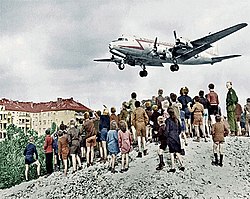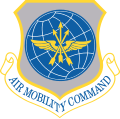29th Weapons Squadron  | |
|---|---|
 A C-130 Hercules from Little Rock, Air Force Base, Arkansas | |
| Active | 1942–1945; 1946–1949; 1953–1955; 1964–1971; 2003–present |
| Country | |
| Branch | |
| Role | Airlift operational testing |
| Part of | USAF Weapons School |
| Garrison/HQ | Little Rock Air Force Base, Arkansas |
| Nickname(s) | F Troop (Vietnam era) [1] |
| Engagements | European Theater Vietnam War |
| Decorations | Distinguished Unit Citation Air Force Outstanding Unit Award with Combat "V" Device Air Force Outstanding Unit Award Vietnamese Gallantry Cross with Palm |
| Insignia | |
| 29th Weapons Squadron emblem (Approved 28 October 2003) [2] |  |
| 29th Tactical Airlift Squadron emblem (Approved 24 August 1943) [3] [note 1] |  |
| Emblem used by the 29th Troop Carrier Squadron in the 1950s. |  |
| Fuselage code while in European Theater [4] | 5X |
The 29th Weapons Squadron is a United States Air Force unit, stationed at Little Rock Air Force Base, Arkansas. It is assigned to the USAF Weapons School at Nellis Air Force Base. The mission of the squadron is to provide advanced Lockheed C-130J Hercules instructional flying.
Contents
- Mission
- History
- World War II
- Army of Occupation and Berlin Airlift
- Cold War
- Vietnam War
- Weapons system training
- Lineage
- Assignments
- Stations
- Aircraft
- See also
- References
- Notes
- Citations
- Bibliography
- External links
The squadron was first activated in 1942 as the 29th Transport Squadron. After training in the United States, it deployed to the Mediterranean Theater of Operations as the 29th Troop Carrier Squadron. The squadron dropped paratroopers in the invasions of Sicily and Italy before moving to England. From England it participated in Operation Overlord. The 29th earned two Distinguished Unit Citations for combat actions. Following VE Day, the squadron returned to the United States where it was inactivated in September 1945.
The squadron was activated again in September 1946 and served with the occupation forces in Italy and Austria before returning to the United States in 1947. In 1948 the squadron moved to Germany, where it participated in the Berlin Airlift until being inactivated in 1949 as American airlift forces in Germany were reduced after the blockade of Berlin was ended. The squadron was activated again at Mitchel Air Force Base in February 1953, when it assumed the resources of the 335th Troop Carrier Squadron, a reserve unit that had been activated for the Korean War, and which was returning to reserve status. The squadron was inactivated in June 1955.
The squadron was again activated in October 1964 at Forbes Air Force Base, Kansas. In December 1965, the squadron moved to Clark Air Base, Philippines, from which it deployed its Lockheed C-130 Hercules transports to support the Vietnam War. In 1971, it moved on paper to Langley Air Force Base, Virginia, where it again worked up on the C-130. Shortly after it became combat ready, however, it was inactivated and its personnel and aircraft were transferred to the 38th Tactical Airlift Squadron, which was simultaneously activated.











